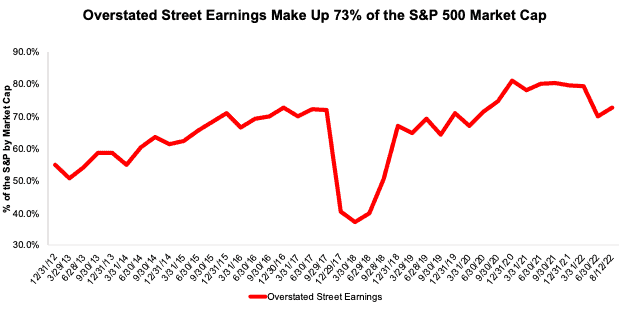Street Earnings, as reflected in Zacks Earnings, are marketed as being adjusted to remove non-recurring items. Our Core Earnings[1] show Street Earnings fail to account for a material amount of unusual items, which distorts investor’s view of profitability across the S&P 500. This report shows:
- the prevalence and magnitude of overstated Street Earnings in the S&P 500
- why Street Earnings (and GAAP earnings) are flawed and not adjusted as promised
- five S&P 500 companies with overstated Street Earnings and an Unattractive-or-worse Stock Rating
Over 180 S&P 500 Companies Overstate EPS by More than 10%
For 340 companies in the S&P 500, or 68%, Street Earnings overstate Core Earnings[2] for the trailing-twelve-months (TTM) ended calendar 2Q22. In the TTM ended 2Q21, 371 companies overstated their earnings.
When Street Earnings overstate Core Earnings they do so by an average of 19%, per Figure 1. For over a third of the S&P 500 (186 companies) Street Earnings overstate Core Earnings by more than 10%.
Figure 1: Street Earnings Overstated by 19% on Average in TTM Through 2Q22[3]
Sources: New Constructs, LLC and company filings.
The 340 companies with overstated Street Earnings make up 73% of the market cap of the S&P 500 through 8/12/22, which is up from 70% through 1Q22, measured with TTM data in each quarter.
Figure 2: Overstated Street Earnings as % of Market Cap: 2012 through 8/12/22
Sources: New Constructs, LLC and company filings.
The Five Worst Offenders in the S&P 500
Figure 3 shows five S&P 500 stocks with an Unattractive-or-worse Stock Rating and the most overstated Street Earnings (Street Distortion as a % of Street Earnings per share) over the TTM through 2Q22. “Street Distortion” equals the difference between Core Earnings per share and Street Earnings per share. Investors using Street Earnings miss the true profitability, or lack thereof, of these businesses.
Figure 3: S&P 500 Companies with Most Overstated Street Earnings: TTM Through 2Q22
Sources: New Constructs, LLC and company filings.
*Measured as Street Distortion as a percent of Street EPS
In the section below, we detail the hidden and reported unusual items that distort GAAP Earnings for Salesforce Inc. (CRM). All these unusual items are removed from Core Earnings.
Salesforce Inc (CRM) TTM 2Q22 Street Earnings Overstated by $2.09/share
The difference between, or Street Distortion in, Salesforce’s Street Earnings ($2.30/share) and Core Earnings ($0.21/share) is $2.09/share, or 91% percent of Street Earnings.
Salesforce’s GAAP Earnings overstate Core Earnings by $0.80/share, which indicates that Street Earnings are more overstated and miss many of the unusual items that distort GAAP Earnings for Salesforce.
Figure 4: Comparing Salesforce’s GAAP, Street, and Core Earnings: TTM Through 2Q22
Sources: New Constructs, LLC and company filings.
Below, we detail the differences between Core Earnings and GAAP Earnings so readers can audit our research. We would be happy to reconcile our Core Earnings with Street Earnings but cannot because we do not have the details on how analysts calculate their Street Earnings.
Salesforce’s Earnings Distortion Score is Miss and its Stock Rating is Unattractive. Salesforce receives an Unattractive rating due to its low return on invested capital (ROIC) of 1% and an expensive valuation. Despite trading at $184/share CRM has an economic book value (EBV), or no growth value, of just $8/share.
Figure 5 details the differences between Salesforce’s Core Earnings and GAAP Earnings.
Figure 5: Salesforce’s GAAP Earnings to Core Earnings Reconciliation: TTM Through 2Q22
Sources: New Constructs, LLC and company filings.
More details:
Total Earnings Distortion of $0.80/share, which equals $793 million, is comprised of the following:
Reported Unusual Gains, Net = $0.69/per share, which equals $685 million and is comprised of:
- $960 million in realized and unrealized gains on equity securities in the TTM period based on
- $712 million in unrealized gains recognized on privately held equity securities in fiscal 4Q22
- $283 million in realized gains on sales of securities in fiscal 4Q22
- -$35 million in unrealized losses recognized on publicly traded equity securities in 4Q22
- $7 million in gains on strategic investments in fiscal 1Q23
- -$37 million in impairments on privately held equity and debt securities in the TTM period based on -$37 million in fiscal 4Q22
- -$245 million in other expenses in the TTM period based on
- -$56 million in fiscal 1Q23
- -$55 million in fiscal 4Q22
- -$102 million in fiscal 3Q22
- -$32 million in fiscal 2Q22
Hidden Unusual Expenses, Net = -$0.04/per share, which equals -$41 million and is comprised of:
- -$41 million in transaction costs associated with acquisitions in the TTM period based on -$54 million reported in the fiscal 2022 10-K
Tax Distortion = $0.15/per share, which equals $149 million
This article originally published on August 26, 2022.
Disclosure: David Trainer, Kyle Guske II, Matt Shuler, and Brian Pellegrini receive no compensation to write about any specific stock, style, or theme.
Follow us on Twitter, Facebook, LinkedIn, and StockTwits for real-time alerts on all our research.
[1] The Journal of Financial Economics features the superiority of our Core Earnings in Core Earnings: New Data & Evidence.
[2] Our Core Earnings research is based on the latest audited financial data, which is the calendar 2Q22 10-Q in most cases. Price data as of 8/12/22.
[3] Average overstated % is calculated as Street Distortion, which is the difference between Street Earnings and Core Earnings.





